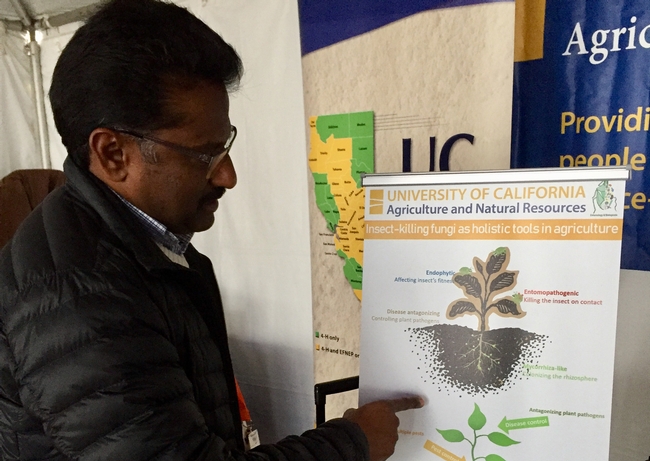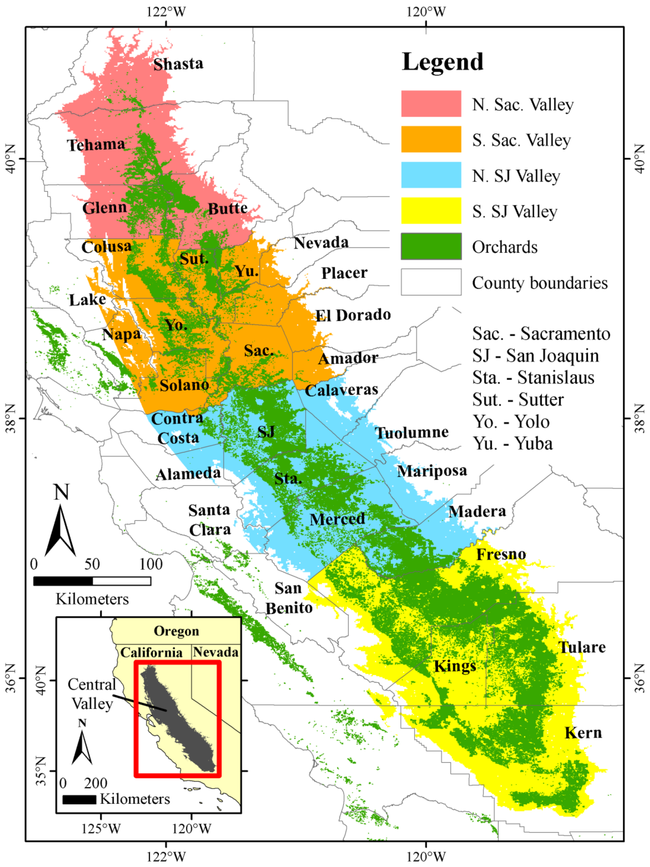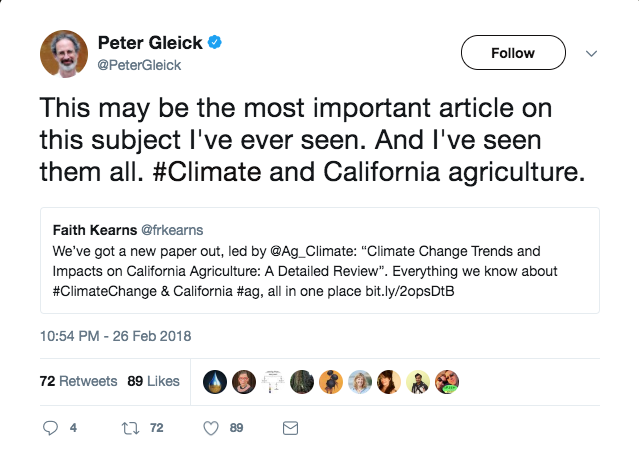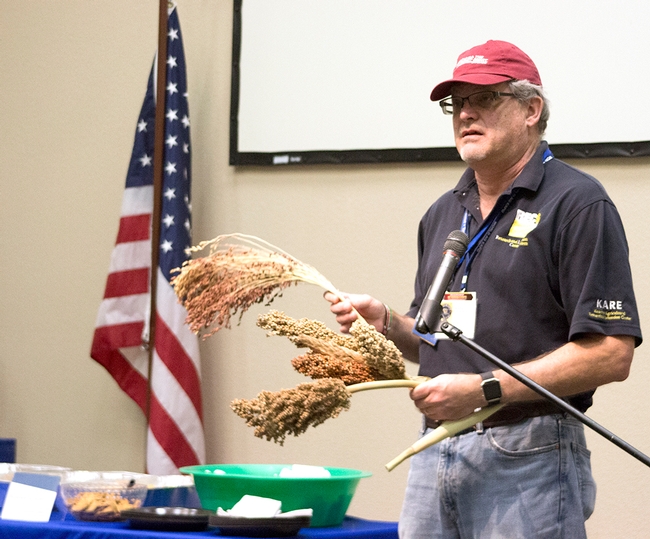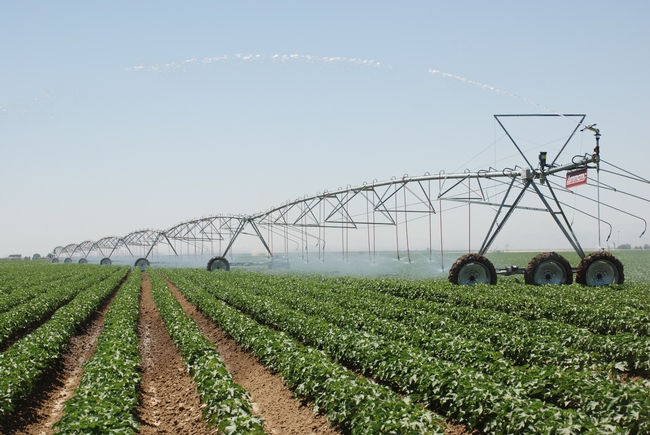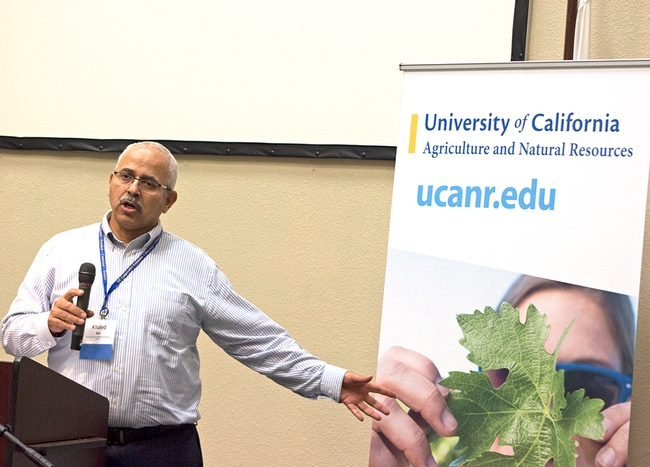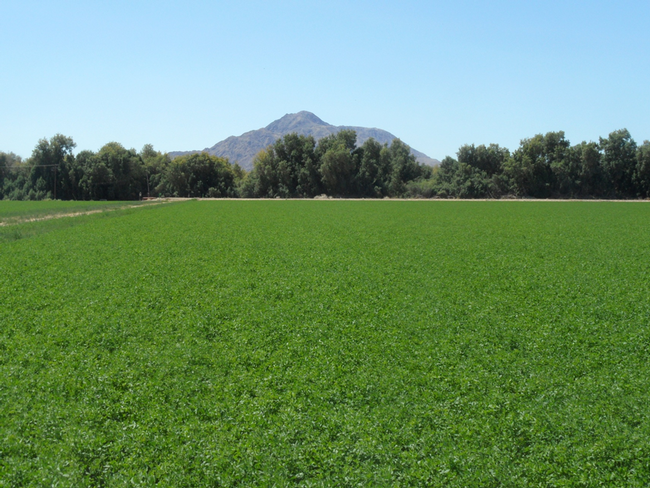Posts Tagged: Khaled Bali
ANR in the news March 1-11
Western Innovator: Putting biologicals to work
(Capital Press) Padma Nagappan, March 11
Early in life, Surendra Dara decided that no matter which field he chose, he needed to make an impact on it. Always interested in science, he chose agriculture and specialized in entomology.
“It attracted me because it dealt with arthropods and there are a lot of physiological similarities to the human world,” Dara said. “It was also critical for growing food and feeding humans.”
Dara is now an entomopathologist with the University of California's Division of Agriculture and Natural Resources in San Luis Obispo, and has an established reputation for exploring innovative options to control pests using microbials as biological controls, and showing growers how they can also help with plant growth, drought resistance and fighting diseases.
Group linked to Ocasio-Cortez seeks ag input after Green New Deal backlash
(Politico) Helena Bottemiller Evich, March 11
After watching that drama unfold, Frank Mitloehner, a leading scientist on agricultural emissions at the University of California, Davis, was thrilled when two outreach staff affiliated with AOC's network reached out to set up a call to discuss the potential for climate mitigation efforts in agriculture. The call, held earlier this month, lasted more than an hour, Mitloehner said.
“I was very glad to inform of what I know, and they were very receptive to it,” Mitloehner said on Agri-Talk last week. During the segment, he urged agricultural producers to not dismiss the left-wing climate effort.
Sudden surge in an unusual crime in Fresno County: Goat theft
(LA Times) Hannah Fry, March 11, 2019
…Picquette's two sons have been raising goats for the last five years as a 4-H project. Losing their animals has been especially hard for the boys, Picquette said, adding that they had planned to use money won during competitions to pay for college.
“They feel very violated. They don't understand how somebody could just come and take something they worked so hard for,” she said. “The bond we have with the goats is incredible. I'm just heartbroken. I don't know if they're scared or hungry. … They've always been treated so well.”
https://www.latimes.com/local/lanow/la-me-ln-fresno-goat-theft-20190311-story.html
California's ambitious plan to stop deadly wildfires may not be enough, experts say
(SF Chronicle) Kurtis Alexander, March 9
… “It's not fair to say that fuel treatments won't do any good,” said Max Moritz, a UC Cooperative Extension wildfire specialist at UC Santa Barbara. “It may provide some protection in some places. But most of us studying this agree that you can't just do this and (expect to) make much headway.”
The plan by the California Department of Forestry and Fire Protection, or Cal Fire, comes at the request of Gov. Gavin Newsom. On his second day in office, Newsom asked the agency to develop a proposal to address the increasingly destructive fire seasons that have rattled the state and are expected to worsen with climate change.
…In the meantime, many researchers say the most effective approach to fire protection is not in the forests, but in communities. They recommend making homes more resistant to fire with hardier construction materials, and clearing the vegetation around them.
“You have to address the home vulnerabilities themselves,” said Moritz at UC Santa Barbara. “If you don't, you're just not going to make a lot of progress on fire.”
After more than 140 years, a massive fig tree gracing the plaza where Los Angeles was founded collapses
(LA Times) Matthew Ormseth, March 9
… The four figs were planted at El Pueblo by agriculturalist and City Councilman Elijah Hook Workman, KCET reported in 2013. The Ficus macrophylla was brought from Australia to Southern California in the 1860s and 1870s, probably to provide shade and ornamentation, said Donald Hodel, a horticulture advisor for the University of California's Cooperative Extension.
Hodel described the Moreton Bay fig as a commanding breed of tree with an enveloping canopy that threw plenty of shade.
His reasons for admiring the Moreton Bay fig: “Their grandeur; their size — they have an imposing habit; their root structure is incredible; the spreading nature of their branches.”
Hodel said he last saw the El Pueblo figs about six years ago.
“I wasn't too impressed by their health or their size, considering they're 140-something years old,” he said.
https://www.latimes.com/local/lanow/la-me-pueblo-tree-falls-20190309-story.html
California's 2018 Was the Worst Ever Recorded for Wildfires
(Gizmodo) Tom McKay, March 9
University of California, Santa Barbara UC Cooperative Extension wildfire researcher Max Moritiz told the Chronicle, “It's not fair to say that fuel treatments won't do any good. It may provide some protection in some places. But most of us studying this agree that you can't just do this and (expect to) make much headway.”
https://earther.gizmodo.com/californias-2018-was-the-worst-ever-recorded-for-wildfi-1833180368
4-H leader who taught lost Benbow girls outdoor skills being flown to Washington, DC for recognition
Kym Kemp, March 7
When Leia Carrico, age 8, and her sister, Caroline, age 5, disappeared into the woods around their home near Benbow on March 1, the whole nation held its breath for the next 44 hours until they were found. But, though their 4-H leaders were worried, too, they say they also knew the girls had something many other children don't–they had survival skills from a class taught by their Outdoor Adventures 4-H project leader, Justin Lehnert.
Lehnert is being honored in Washington, DC, on Tuesday for his role in teaching Leia and Caroline outdoor skills.
Researchers highlight plan to eat healthy on a budget
(Consumer Affairs) Kristen Dalli, March 7
Following a healthy diet can come with a hefty price tag, but a team of researchers has outlined a way for consumers to stick to a healthy diet -- and also stick to their budgets.
According to the team, consumers -- and their families -- can have healthy meals if they focus on buying items in bulk and planning meals in advance.
“This study determines the likelihood that families living in low-income households could create meals that meet the USDA dietary guidelines presented in MyPlate nutrition education materials,” said researcher Karen M. Jetter, PhD. “In addition to food cost, the other factors considered were access to stores, time for meal preparation, and whether the menus included culturally appropriate foods.”
Healthy eating is possible on a limited budget, study shows
Study: Eating healthy on a budget is possible
https://www.upi.com/Study-Eating-healthy-on-a-budget-is-possible/9951551904010/
Eating Healthy Is Possible on a Small Budget, Says Study
https://www.askmen.com/news/sports/eating-healthy-is-possible-on-a-small-budget-says-study.html
Sorry, Alexandria Ocasio-Cortez, but “farting cows” aren't the problem
(New Food Economy) Sam Bloch, March 7
…As it turns out, neither side was accurate. Republicans are likely to continue linking Green New Deal priorities to a supposed hamburger ban. But if you don't hear about cow farts anymore from AOC, it may not be because of GOP criticism. Frank Mitloehner, an animal scientist and air quality specialist at the University of California, Davis, insists cattle flatulence isn't the problem it's made out to be, and says he helped set the record straight.
Here's what seems to have happened. On February 4, shortly before Ocasio-Cortez announced the Green New Deal, she was speaking to school children in Queens, New York. When one asked how they could “combat” climate change, Ocasio-Cortez offered two practical options—stop using disposable razors, and skip meat and dairy for one meal.
Mitloehner tweeted at her.
“Dear @AOC: we all try to help the climate,” he wrote. “However, the two options you offered have low impacts compared to the 800lb gorilla, which is to reduce fossil fuel use. About ? of greenhouse gas emissions in the US stem from transport and energy prod&use. Meat/milk = 4 % of total GHG,” referring to findings in a recent EPA report.
… “I give her team a lot of credit for reaching out,” Mitloehner says. “If we really are serious about making a difference in carbon emissions, you cannot do this without agriculture involved.”
California supplies a quarter of the world's sunflower seeds
(Capital Press) Padma Nagappan, March 7
…Khaled Bali is a University of California Department of Agriculture and Natural Resources statewide water and irrigation specialist who has been working since 2016 on a four-year trial on sunflower varieties.
He was asked by the University of Georgia to help ascertain which varieties were drought resistant. He chose to conduct his trial in the low desert region of the Imperial Valley, since it gets little rain during the growing season between February when it's planted, and June when it's harvested. This would make it easier to control and measure the actual water applied to the crop varieties.
“We're looking at 285 varieties of sunflowers, to see which ones do well under stress,” Bali said. He has tested different plantings each growing season for the past three years, and will finish the trial this year.
https://plantingseedsblog.cdfa.ca.gov/wordpress/?p=17375
Livestream coverage of fire protection panel discussion in Nevada City
(Sierra Sun) March 7
…Following the films, the community is invited to join an ongoing conversation around the new reality of living with fire in the wildland urban interface. Panelists represent a diverse cross-section of the wildfire prevention community including: Cal Fire, Fire Safe Council of Nevada County, Nevada County Office of Emergency Services, Nevada County Resource Conservation District, Pacific Gas and Electric Company, Tahoe National Forest and University of California Cooperative Extension. The panel discussion will be moderated by YubaNet Co-founder Pascale Fusshoeller. [Kate Wilkin, UCCE fire advisor, participates on the panel in the last hour of the video.]
Bees, blooms off to slow start
(Western Farm Press) Logan Hawkes, March 6
…This year, almond bloom started around a normal time, with some early varieties showing a few open flowers in the first week of February,” reported Franz Niederholzer, UCCE farm advisor for Colusa, Sutter, and Yuba Counties. “For most of the month bloom progressed very slowly,”
By the middle of February, he says, “bloom for Nonpareil was at least two weeks behind, and bee hours were limited until the last week of the month. Last year, between Feb 1-20, we accumulated 130 bee hours of good honey bee flying weather [55 F., no rain, and wind less than 10 mph]. For the same interval this year, we had around 10 hours and only six of those occurred with open flowers in the orchard.”
On the positive side of the slow start, Niederholzer says, the colder weather tends to suppress activity of key bloom diseases such as blossom brown rot and anthracnose. “However, cold weather at bloom was conducive to blossom blast (pseudomonas) bacteria, and some growers were considering adding materials to their normal bloom fungicides with bactericide activity.”
https://www.farmprogress.com/tree-nuts/bees-blooms-slow-start
Wet winter aids groundwater replenishment
(Ag Alert) Christine Souza, March 6
… Helen Dahlke, a hydrology expert and professor with the University of California, Davis, Department of Land, Air and Water Resources, has been working with farmers, studying on-farm groundwater recharge locations and suitability for various crops.
"In many regions, we can definitely do more actively recharging our groundwater aquifers," said Dahlke, who currently has trials on alfalfa at the UC Kearney Agricultural Center. "It really depends on what region, how much surface water is available for recharge, what kind of sediment structure or hydrogeology we have underneath and whether it's suited for conveying large amounts quickly."
Despite abundant precipitation in recent weeks, she said the timing is not the best for studying impact of recharge on certain crops.
"We prefer on-farm recharge to happen in January and February, just because that is considered the dormancy season for most crops," Dahlke said. "With almond trees already blooming, often there is a greater risk of applying water on those crops."
She said recent precipitation has helped groundwater recharge overall, but there is "very little way of estimating how much it is helping."
http://www.agalert.com/story/?id=12797
Drip irrigation improves yields of Imperial sugar beets
(Ag Alert) Padma Nagappan, March 6
Halfway through a two-year irrigation trial to test furrow irrigation versus drip on sugar beet in California's Imperial Valley, Ali Montazar is looking for ways to boost yields with as little water consumption as possible in a region where furrow irrigation is the common practice.
Montazar, irrigation and water management advisor with the University of California department of agriculture and natural resources (UCANR) in Imperial County, is comparing and evaluating sugar beets for crop water use, sugar percentage, and yield, using both furrow and drip, since growers are now thinking of switching to subsurface drip.
Preliminary results from year one of the trial show that yield and crop water use are better with drip. Yield was 21 percent higher, and water use was a few points lower.
http://www.agalert.com/story/?id=12782
NFU says “No” to Green New Deal
(DTN) Jerry Hagstrom and Chris Clayton, March 6
Frank Mitloehner, an animal-science professor and air-quality Extension specialist at the University of California-Davis, reached out to Ocasio-Cortez's team about agriculture and the Green New Deal after seeing social media posts late last month about “farting cows” that drew a great deal of attention.
“I appreciate her interest in climate-change mitigation, but the 800-pound gorilla is the use of fossil fuels, and I told her that even the notion of cow flatulence makes this whole thing sound silly, and that's not what we need this discussion to be,” Mitloehner told DTN in an interview.
From Farting Cows to More Beans; Anti-Livestock Claims Fall Short
(AgriTalk) Jennifer Shike, March 5
The EAT-Lancet Commission on Food, Planet, Health is backpedaling as industry leaders and scientists poke holes in its “planetary diet” released in mid-January that is supposed to improve human health and planet health.
Air Quality Extension Expert Frank Mitloehner of the University of California Davis joined Chip Flory on AgriTalk Monday to discuss EAT-Lancet and Green New Deal in more depth.
4-H instructor who taught NorCal sisters how to survive in wilderness speaks out
(ABC7) Dion Lim, March 4
ABC7 News spoke exclusively to the 4-H instructor who taught two young girls the life-saving skills they needed to survive a weekend lost in the woods.
… Their mom, Misty Carrico, says she's not sure her daughters would have survived, if not for their 4-H program.
"The group leader Justin has taught them fire making skills and wilderness survival skills."
Justin Lehnert, the girls' 4-H leader, said, "I'm ecstatic that they did the job that they did. They're very strong girls and they stayed calm."
… Nine-year-old Caroline Gelormini has been a member of the San Bruno-South San Francisco 4-H Program for five years. Thanks to 4-H, she feels like she'd have a shot at surviving in the woods too.
Ocasio-Cortez Seeks Ag Data on Green New Deal
(Drovers) John Herath, March 4
When freshman congresswoman Alexandria Ocasio-Cortez released her Green New Deal plan, social media lit up with talk of her plan's mentions of “farting cows.” That drew the attention of agriculture's preeminent expert on air quality, Dr. Frank Mitloehner of the University of California at Davis, who tweeted back at the congresswoman.
“I don't know whether my tweet was the reason, but a few hours after I tweeted her, all mentioning of cow flatulence were taken off the web pages and of all social media outlets and was never to be heard again,” Mitloehner told Chip Flory on the AgriTalk Radio Show Monday.
https://www.drovers.com/article/ocasio-cortez-seeks-ag-data-green-new-deal
2 missing Humboldt County girls found — ‘absolute miracle
(SF Chronicle) Michael Cabanatuan, March 3
…Little additional information was available on how the girls went missing or how they survived, but Honsal said they had been trained in outdoors survival as members of a 4-H program.
https://www.sfchronicle.com/news/article/Absolute-miracle-as-missing-Humboldt-County-13659375.php
Organic farm east of Denair does its part on climate change. It's getting an award
(Modesto Bee) John Holland, March 2
…The family won in the farmer/rancher category of the Climate Leadership Awards. The others:
- Researcher: Tapan Pathak of the University of California Cooperative Extension in Merced, who helps farmers adapt to climate change.
- Policymaker: Ken Alex, who was director of former Gov. Jerry Brown's Office of Planning and Research
- Legislative staff: Brett Williams, office of Assemblywoman Jacqui Irwin, D-Thousand Oaks
- Agricultural professional: Ruth Dalquist-Willard, UC Cooperative Extension, Fresno
https://www.modbee.com/news/article226956529.html
Eructation Inflation: Greenhouse Gas Emissions of Livestock
(Science for the Rest of Us) March 1
Put your nerd hat on -- we cover a lot of ground in this fast-paced discussion with Dr. Frank Mitloehner of the University of California-Davis about the greenhouse gas emissions associated with the meat and dairy we consume. We consider how livestock emissions compare to other sectors of the US and global economies, the carbon footprint of vegetarian diets and what is the most effective way to reduce individual carbon emissions.
Keeping the Carbon Footprint of Livestock in Perspective
(AgNet West) Brian German, March 1
…“It is irresponsible and it's misguiding the public to believe that the true sources of pollution are downplayed, and the impacts of animal agriculture are grossly inflated,” said Dr. Frank Mitloehner, Professor and Air Quality Specialist in Cooperative Extension in the Department of Animal Science at the University of California, Davis.
California agriculture industry must act now to adapt to climate change
"This article received more than 1000 views in less than a day," Pathak wrote in an email to colleagues.
The review article summarizes historical and future climate trends and their impacts on California agriculture. The authors also suggest adaptation and mitigation strategies.
Shortly after Kearns, California Institute for Water Resources academic coordinator, tweeted, “We've got a new paper out, led by @Ag_Climate: “Climate Change Trends and Impacts on California Agriculture: A Detailed Review”. Everything we know about #ClimateChange & California #ag, all in one place http://bit.ly/2opsDtB,” journalists took notice.
“Climate change could decrease the yield of some crops in the state by up to 40 percent by 2050. That's a big deal for farmers growing more than 400 commodities,” Ezra Romero of Capital Public Radio reported. “Tapan Pathak, a UC Cooperative Extension specialist based in Merced, and his research team analyzed more than 90 studies on climate change and discovered that warming temperatures may alter where crops grow across California. Their findings were published in Agronomy Journal.
“In order to make California agriculture more sustainable we have to act now,” Pathak said.
Ian James of the Desert Sun spoke with Kearns. “One under-appreciated aspect of California's climate is how important our temperature envelope is to California's agricultural sector. The right temperatures at the right times are absolutely crucial,” said Faith Kearns, a scientist with the California Institute for Water Resources who was part of the team. “For example, warm weather in January and February can reduce almond yields, but warm summers can reduce peach yields. So, there really is no-one-size-fits-all adaptation approach.”
In her report for KQED, Amel Ahmad noted, “Climate scientist and author Peter Gleick called it the most important report he's seen on the impact of climate change on California agriculture.”
The study was also covered in Courthouse News Service by Nick Cahill, Think Progress by Natasha Geiling, Digital Journal by Karen Graham, Grist by Nathanael Johnson, NPR by Ezra Romero, Modern Farmer by Dan Nosowitz and Fresno Bee by Brianna Calix.
This study was supported by the UC President's Carbon Neutrality Initiative and UC ANR.
The drought may be over, but water concerns haven't been doused
Record winter rainfall during the 2016-17 winter has enabled farms to emerge from survival mode in the short term, but scientists are still working hard to be ready for the next drought, reported Tim Hearden in Capital Press.
Hearden spent a day at the UC Kearney Agricultural Research and Extension Center in Parlier to learn how researchers at the facility and the UC West Side Research and Extension Center near Five Points are combining technology with management practices to put every drop of irrigation water to work.
“This is one of the few places in the world where you can do drought research on a field level,” said Jeff Dahlberg, director of the 330-acre Kearney facility. “What I'm planning is a world-class drought nursery.”
At the West Side REC, researchers are working with farmers to perfect micro-irrigation efficiency and test drought stress on the area's most prevalent crops.
“We'll grow a tremendous number of cultivars of a crop” and identify “what seem to be the most promising cultivars when you grow them under drought conditions,” said Bob Hutmacher, a cotton specialist and the center's director.
Hearden spoke to Jeff Mitchell, UCCE cropping systems specialist and director of the Conservation Agriculture Systems Innovation center (CASI). CASI is encouraging farmers to adopt farming practices that save water, reduce dust and help improve the condition of soil, such as subsurface drip irrigation, overhead irrigation, minimum tillage, cover crops and crop residues.
“This is not done right now in California,” Mitchell said. “In the future, there may be a strong likelihood of certain agricultural sectors adopting these practices.”
Other subsurface irrigation trials are showing dramatic increases in yields. Khaled Bali, an irrigation water management specialist at Kearney, said underground drip systems in alfalfa fields have achieved 20 to 30 percent more yields while in some cases using 20 percent less water.
Kevin Day, a UCCE pomology advisor in Tulare County, is trying subsurface drip in a peach and nectarine orchard after working with the USDA to use it for pomegranates. He's seen as much as a 90 percent reduction in weeds because there's no surface water to feed them.
“Fewer weeds, fewer pesticides,” he said. “We use high-frequency irrigation. We irrigate as the crop needs it. When you do that, you keep the roots deeper, which makes for better aeration.”
UC ANR vice president Glenda Humiston visits the Imperial Valley
Humiston visited local farms, the Salton Sea, and UC Desert Research and Extension Center and UC Cooperative Extension in Imperial County. She had discussions with local farmers and industry representatives about renewable energy, drought and water issues, and agricultural production.
"It's great ot have our new vice president here to learn about the programs that we have here and discuss how we can improve them and bring more resources to the area," said Khaled Bali, director of UCCE in Imperial County. "That is basically my objective, bringing more resources to the area and have more collaborative projects."
Andy Horne, a Imperial County executive, said that solar farms have expanded in the county. Projects in place and those approved will cover about 4 percent of Imperial County farmland, a level the county intends to maintain. Humiston told the reporter that she is an advocate for farmland protection because the planet as a whole has a limited surface for cultivating crops.
"As we are dealing with things such as climate change and invasive species and drought, not only protecting those acres so that they are available but keeping them healthy and making sure water is available becomes ever more important," Humiston said.
Delgado reported that Humiston's trip to the Imperial Valley is part of an effort to visit all the UC Cooperative Extension offices and the nine research and extension centers around the state to familiarize herself with UC ANR efforts throughout California.
“The issues going on here are completely different than the Central Coast, Northern Sierras or Sacramento Valley,” Humiston said. “What is important is that we, the University of California, we have these offices in each and every county and that we have these research centers because if we are going to develop knowledge and find solutions and be able to implement those, we got to be able to have people in the ground here that can really dig into the real problem. You got to have people on the ground.”
Drip irrigation in alfalfa cuts water use, but isn't for everybody
The drought is forcing farmers to reexamine the way they water their crops, but converting to drip irrigation in alfalfa is unlikely to be widely implemented, reported David Wagner on KPBS Radio News.
The drip irrigation system conserves water - almost by half, said farmer Jack Cato - but is expensive and requires regular maintenance. After six years, the drip system is yet to pay for itself.
"Drip irrigation is not the answer for everything," said Khaled Bali, irrigation advisor with UC Agriculture and Natural Resources (UC ANR). "I would not recommend switching every acre in the Imperial Valley to drip irrigation."
Cato added that new drip irrigation users face a steep learning curve.
"Whatever farm starts doing this, he needs to take baby steps," Cato said. "It's not something you learn overnight, or in a book. You have to study your fields daily."
For more on water use and alfalfa, see Why alfalfa is the best crop to have in the drought by Daniel Putnam, UC ANR Cooperative Extension specialist based at UC Davis, in the Alfalfa & Forage Blog.

